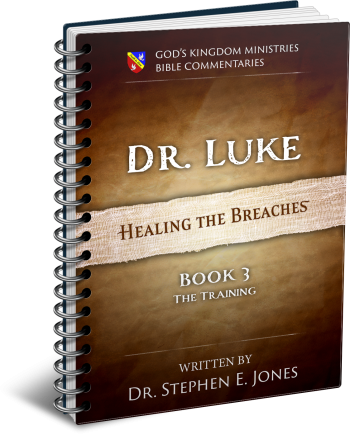Latest Posts
View the latest posts in an easy-to-read list format, with filtering options.

This book covers Luke 7-9, expounding on the main teachings of Jesus as He trained His disciples. It climaxes with His Transfiguration, which is a prophetic picture of the manifestation of the Sons of God at the end of the Age.
Category - Bible Commentaries

There is an interesting series of prophetic events leading to Jesus’ transfiguration. The full sequence is seen mostly in Matthew’s account, because he includes the story of Peter walking on the water in Matt. 14:28-31. Luke is completely silent on the story, moving directly from the event where Jesus fed the 5,000 to Caesarea Philippi and Mount Hermon, where He was transfigured.
Yet Matthew’s account is confirmed by John 6, telling us that after Jesus fed the 5,000, He sent His disciples across the lake while He went up a mountain alone to pray. The disciples, got stuck in a storm in the middle of the lake, and Jesus went to them, walking on the water. Peter went out to meet Him, returned with Him to the boat, and suddenly they found themselves at Capernaum, “the covering of the Comforter.”
From there, Jesus took the disciples to Caesarea Philippi north of the Sea of Galilee, where Jesus’ identity as “the Christ, the son of the living God” was established by Peter’s revelation (Matt. 16:16). They spent about a week in Caesarea Philippi and then took a trip up Mount Hermon, where Jesus was transfigured.
The story is prophetic of the metamorphosis which will be experienced by the Sons of God at the second coming of Christ, as Paul prophesies in 1 Cor. 15:51-53. The dead overcomers will be raised, but those living at the time will just be “changed,” or transfigured without going through death and resurrection.
Scripture teaches us something about the steps leading to this transfiguration. Note first that when Peter gave his great confession of Christ’s identity, Jesus called him “Simon Barjonah,” or Simon, Son of Jonah (Matt. 16:17). Because of the highly figurative nature of Hebrew words, his identification as “son of Jonah” links him with the original prophet by that name.
It is interesting, then, that when Peter got out of the boat, he began to sink when he focused on the wind and waves (Matt. 14:30). The prophet Jonah too was cast overboard, sank in the sea, but yet was rescued by the hand of God. Take note also that in the scene on the lake, Jesus called him Peter, not Simon. The names themselves are prophetic. Peter means “a stone or rock,” because Peter sank like a rock.
In the next prophetic scene, however, which took place in Caesarea Philippi, Peter received revelation that Jesus was the Messiah Himself. Perhaps he already knew this in his head, but this was the moment when it became a revelation to him. Hence, Jesus called him “Simon Peter,” for Simon means “hearing.” He had heard the voice of God and received the revelation in his heart.
The name Simon Peter means “the hearing rock.” In other words, he was acting the part of the second rock that Moses was supposed to speak to in Num. 20:8,
8 Take the rod; and you and your brother Aaron assemble the congregation and speak to the rock before their eyes, that it may yield its water…
Recall that the first time the rock brought forth water, Moses was supposed to strike it with the rod (Exodus 17:6). The second time, however, he was supposed to speak to it, because the rock would hear his voice and bring forth water. These two occasions prophesy of the two works of Christ and have everything to do with the prophet Jonah.
In Christ’s first coming, He came to be struck, or “smitten” (Isaiah 53:4), and so when He was crucified, the spear in His side brought forth water as well as blood. Yet Christ’s second coming was not to be a death work but a “speaking” work. This is what was to be pictured in the hearing rock that was to bring forth water for the people.
Nonetheless, Moses struck that rock too, which disqualified him from receiving the inheritance of the Kingdom. Why? Because he broke the type, and so another (Joshua) was called to represent the second manifestation of Christ. Many Christians today are doing the same thing that Moses did, unable to get past the cross and its message of Passover (death). Hence, they crucify Christ continually in word and in life, unable to discover the Tabernacles message in the second work of Christ.
Jonah, being a type of Christ, received two calls to go to Nineveh. These represent the two manifestations of Christ. The first calling resulted in his experience of death in the belly of the fish and his resurrection when the whale vomited him upon the shore. But then Jonah received a second call in Jonah 3:1, 2,
1 Now the word of the Lord came to Jonah the second time, saying, 2 “Arise, go to Nineveh the great city and proclaim to it the proclamation which I am going to tell you.”
This time Jonah responded to the call of God, preaching the word in Nineveh, and the people heard. The second work of Christ involves preaching the word, at which time the people’s ears are opened, they hear, and they are converted in the greatest evangelistic work of all time.
That is the nature of the second work of Christ in our time. The work will be lengthy, but it will result in the earth being filled with His glory.
Getting back to Simon Peter Barjonah, we see that he is a type of Christ in this portrait. The first story pictures him as obedient unto death, for he gets out of the boat but sinks in the waves. He is then “resurrected” by the hand of God and identified as the rock that sinks but is rescued from the watery grave.
This scene was prophesied in Psalm 69, which is one of the great messianic prophecies of the suffering of Christ at the cross. Psalm 69:1 says, “Save me, O God; for the waters have threatened my life.” The waters speak of the abyss of death, illustrated by Jonah and by Peter, son of Jonah.
In the second story, he is called Simon Barjonah, the hearing rock, whose confession of faith represents the revelation of Christ’s identity that was to be preached to the multitude in Nineveh. Nineveh means “Fish City.” Here Peter received the key to successful world evangelism, in accord with Jesus’ earlier promise at Peter’s calling (Luke 5:10), where Jesus told him that he would learn to become a fisher of men. In other words, he was to preach the revelation of the identity of Jesus as the Messiah, or Christ.
From Caesarea Philippi, Peter accompanied Jesus, along with James and John, up Mount Hermon to witness Jesus’ transfiguration. Although they did not yet truly understand what was happening until later, the story shows how the second work of Christ would be accomplished. The transfiguration of the Sons of God is foreshadowed by Jesus’ own transfiguration, for we are identified with Christ as His Body. Rom. 6:5 tells us,
5 For if we have become united with Him in the likeness of His death, certainly we shall be also in the likeness of His resurrection.
It is by the transfiguration and empowerment of the feast of Tabernacles that the sons of God are assured success as fishers of men in Nineveh.
The steps to transfiguration, then, are as follows: First, we identify with His death and resurrection, as Peter did when he walked on the water, sank, and was rescued from the watery grave. Then we hear the second call of Jonah and receive the revelation of the message that is to be preached in the time of the second work of Christ. It is the message of Tabernacles, rather than Passover, and the conversion of the world is the result.
Step three is transfiguration, or the manifestation of the Sons of God, an event which Paul describes in Rom. 8:19-21,
19 For the anxious longing of the creation waits eagerly for the revealing [unveiling, or manifestation] of the sons of God. 20 For the creation was subjected to futility, not of its own will, but because of Him who subjected it, in hope 21 that the creation itself also will be set free from its slavery to corruption into the freedom of the glory of the children of God.
The manifestation of the sons of God is not the end of the story. It is only the beginning of a massive work of world evangelism that will convert the entire city of Nineveh. Up to now, in the wake of the first work of Christ, we have fished from the left side of the boat. The left side speaks of judgment. Fishing on the left side shows that the Church has been trying to be fishers of men by preaching divine judgment.
We need to cast our nets on the right side of the boat, as Jesus instructed in a related prophetic story (John 21:6). The right signifies a message of the mercy of God. It is the message of the Restoration of All Things. It is the good news that divine judgment is restorative, not destructive. It is correction, not just punishment.
Likewise, Jesus told the disciples on two occasions to cast their nets out to obtain fish. The first time their nets broke, because the nets were not strong enough to hold them. The second time (after Jesus’ resurrection) the nets did not break, for this represents the revelatory message of the second work of Christ.
It is all about catching “fish” in Fish City—Nineveh, the capital of Assyria, Israel’s great “enemy.” It is about God’s enemies being converted, rather than destroyed. It is about the great longing of creation to be set free by the manifested Sons of God. This manifestation will not be the end of the story, as so many have been taught. It will be just the beginning of the greatest fishing expedition ever seen in the history of the world.
In other words, the transfiguration, or “change,” as Paul puts it, is not the goal, but the means to the end. Transfiguration is not about retirement on a cloud with a harp. It is about being empowered to be successful fisher of men in order to fulfill the expectations of creation itself. Only then will we truly see the Kingdom of God emerge visibly in the earth. Only then will we see the earth itself transformed, cleansed of its pollution and sin, with endless wars ceasing, and with the nations rejoicing because of the divine justice (with mercy) toward all (Psalm 67:4).